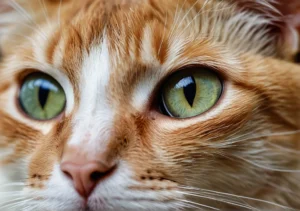Cats always seem to be portrayed as evil in movies, but why is that? Let’s explore the reasons behind this common trope.
The Origins of the Evil Cat Stereotype
Have you ever wondered why cats are so often portrayed as evil in movies? The origins of this stereotype can be traced back to ancient folklore and literature. In many cultures, cats were associated with mystery, magic, and the supernatural. The Egyptians, for example, revered cats as sacred beings with mystical powers. This enigmatic reputation carried over into European folklore, where cats were often depicted as companions to witches and sorcerers.
In literature, authors like Edgar Allan Poe and H.P. Lovecraft further perpetuated the idea of cats as sinister and otherworldly creatures. Poe’s infamous story, “The Black Cat,” portrays a feline companion that brings about the downfall of its owner, emphasizing the idea of cats as harbingers of misfortune. Lovecraft’s works often feature cats as guardians of ancient and eldritch knowledge, adding to their mystique and malevolent reputation.
Cat Behavior in Film
When it comes to cats in movies, certain behaviors and characteristics are often highlighted to reinforce their villainous image. Cats are known for their independence and aloofness, traits that can be easily twisted into portrayals of coldness and cruelty on screen. Their silent movements and mysterious nature lend themselves well to creating an aura of suspense and danger in cinematic settings.
Furthermore, the association of cats with darkness, nighttime, and the supernatural adds to their menacing portrayal in films. The way they slink around corners, their glowing eyes in the dark, and their ability to move silently create an air of mystery and unpredictability that filmmakers love to exploit. These characteristics, combined with their sharp claws and occasional predatory behavior, make cats the perfect antagonists in many movie plots.
So, the next time you watch a movie with an evil cat character, remember that their portrayal is rooted in centuries of folklore and literature, as well as the specific behaviors and traits that filmmakers use to craft memorable and menacing feline villains.
Cultural Influence on Cat Portrayal
Cats have garnered a notorious reputation in movies due to deep-rooted cultural beliefs. In ancient Egypt, cats were revered and associated with goddesses like Bastet, symbolizing protection and fertility. However, during the Middle Ages in Europe, cats were linked to witchcraft and dark forces, leading to their demonization. These historical perspectives have seeped into modern media, shaping the portrayal of cats as sly and malevolent beings. The lingering cultural influence perpetuates the image of cats as villains in films, tapping into our collective subconscious bias against these enigmatic creatures.
Psychological Explanation
Our perception of cats as evil in movies can be attributed to psychological factors ingrained in human nature. Cats possess a mysterious aura, often appearing aloof and independent, which can trigger feelings of unease and uncertainty. Additionally, their nocturnal nature and stealthy movements evoke primal fears linked to the unknown and darkness. These subconscious fears combine with cultural stereotypes to create a potent image of cats as cunning and devious adversaries on the big screen. The projection of our fears and biases onto these feline characters adds depth and complexity to their portrayal as antagonists.
Additional Insight: 1. Cats’ slit-like pupils, which dilate in low light to enhance night vision, may contribute to their sinister on-screen persona. This unique ocular feature can make cats appear intense and predatory, reinforcing their portrayal as menacing figures in movies.
Alternatives to the Evil Cat Trope
Cats in movies are often portrayed as sneaky, cunning, and downright evil. But let’s shake things up a bit and look at some films that break away from this stereotype. In the movie “Homeward Bound: The Incredible Journey,” the cat, Sassy, is a brave and loyal companion on a journey with two dogs. She shows courage and determination, proving that cats can be just as heroic as any other animal. Another example is the beloved film “Puss in Boots,” where the titular character is a charming and swashbuckling hero. This cat is confident, clever, and always ready to help those in need. These movies remind us that cats can be portrayed in a positive or neutral light, adding depth and variety to their on-screen representation.
Mythbusting Misconceptions about Cats
Have you ever heard that cats are inherently evil or malicious? Let’s debunk some common misconceptions about feline behavior that may contribute to their negative portrayal in movies. Contrary to popular belief, cats are not always aloof and uncaring. In reality, cats can be affectionate, loving, and incredibly loyal to their human companions. Additionally, the idea that cats are always plotting schemes or causing trouble is simply a myth. Cats are independent animals with unique personalities, just like dogs or any other pet. By understanding and appreciating their individual traits and behaviors, we can see that cats are far from the sinister creatures often depicted on the big screen. So next time you encounter a cat in a movie, remember that they are more than just a villainous stereotype – they are complex and fascinating creatures deserving of respect and understanding.
Behind the Scenes of Cat Training
When it comes to the mysterious world of cat training for movies, it’s essential to understand the unique challenges that filmmakers face when working with these independent felines. Unlike dogs, cats are known for their unpredictable behavior and resistance to traditional training methods. This can often result in a portrayal of cats as aloof or even villainous on screen.
One key technique used in cat training for films is positive reinforcement. By rewarding desired behaviors with treats or praise, trainers can encourage cats to perform specific actions on cue. However, due to the nature of cats, this process can be time-consuming and require a great deal of patience.
Another factor that may influence the portrayal of cats in movies is the selection process for on-screen felines. Cats with certain personality traits, such as confidence and curiosity, may be more likely to succeed in a film environment. This can inadvertently lead to a bias towards casting cats that exhibit more assertive or mischievous behaviors, reinforcing the stereotype of cats as villains in movies.
Unique insight: While cats may be portrayed as evil in movies, it’s important to remember that their behavior is often shaped by the training techniques and casting choices made behind the scenes. By understanding the challenges faced by filmmakers and the tendencies of these enigmatic animals, viewers can gain a new perspective on the portrayal of cats in cinema.
The Future of Cats in Cinema
As filmmakers continue to push the boundaries of storytelling, there is hope for a more diverse and nuanced portrayal of cats in movies. By exploring different aspects of feline behavior and showcasing a range of personalities, filmmakers can move away from the traditional evil stereotype towards more authentic and relatable representations.
One potential avenue for change is the inclusion of positive cat characters in films. By highlighting the affectionate, playful, and loyal aspects of cats, filmmakers can challenge the negative stereotypes that have been perpetuated in the past. This shift could open up new storytelling opportunities and allow for a more balanced representation of cats on screen.
Additionally, advancements in technology may offer new possibilities for working with cats in movies. CGI and animatronics can be used to create realistic and expressive feline characters, giving filmmakers greater control over their on-screen presence. This could lead to a more diverse range of cat characters and pave the way for a more inclusive and accurate depiction of cats in cinema.
In conclusion, while cats have often been typecast as villains in movies, there is potential for change in the future. By challenging stereotypes, exploring new storytelling techniques, and embracing technology, filmmakers can create a more nuanced and realistic portrayal of cats on screen. Let’s look forward to a future where cats in cinema are as diverse and complex as they are in real life.
Alex, a passionate animal lover, has experience in training and understanding animal behavior. As a proud pet parent to two dogs and three cats, he founded AnimalReport.net to share insights from animal experts and expand his knowledge of the animal kingdom.




